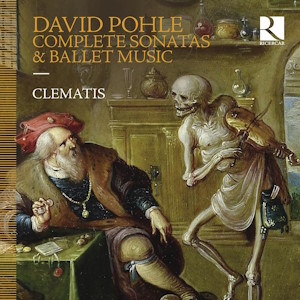
David Pohle (1624-1695)
Complete Sonatas & Ballet Music
Clematis
rec. 2021-23, Église Notre-Dame de Centeilles & Église Saint-Apollinaire de Bolland, France; Begijnhofkerk, Sint-Truiden, Belgium
Ricercar RIC460 [2 CDs: 152]
In a recent review of music of this era, I expressed the thought that “I would be better served sticking to the handful of discs of this type of music that have really delighted me” because I had had a run of disappointments. A month later, I am back again. While the name of this German composer was unknown to me, I did know the Belgian ensemble Clematis, and it was the reason to request this set for review. In 2014, I reviewed a recording by the group of music by the Vitalis (review), and it was one of my Recordings of the Year. Two years later, Clematis returned with a disc of music by Legrenzi, and while I was less enthused by the music, the performances remained outstanding.
David Pohle was born in Saxony, and his musical training began in Dresden with Heinrich Schütz; a rather good way to begin, I’m sure you will agree. He worked in a number of small courts around the German states, before being appointed Concertmaster (and eventually Kapellmeister) in Halle, where he spent around twenty years, becoming friendly with the duke’s personal valet and surgeon, Georg Händel (father of GF). Much of his considerable output has been lost, and what remains is scattered around various libraries in Germany and Sweden. This recording presents his remaining twenty-nine sonatas (for four to eight instruments) and two set of dances.
Now the thirty-one works were, of course, not intended to be listened to as a block, rather singly or a few together, so do work your way through them a few at a time. To that end, I have a comment about the programming of the works across the two discs. Starting with G.24, which has a particularly funereal opening minute, was not a great idea, even if there are some splendid and more energised sections within. There is a roughly even division between major and minor keys, but the ordering is such that there are blocks of one or the other: we start with 4 minor, then 10 major, 9 minor, 5 major. Given that the minor key works are, on the whole, relatively sombre, I think starting with four and then later on having nine in a row is not ideal. Alternating major and minor to provide ongoing contrast would have been a better approach, I feel.
Pohle is perhaps not the greatest melodist one has ever encountered, but his rhythmic sense and ear for colour from the relatively restricted palate are not in doubt. There is a consistency in the sonatas, in terms of their quality, so that I don’t think I can pick out particular gems. To introduce yourself to Pohle’s music, my suggestion is to randomly pick out one major and minor key sonata, and also one of the sets of dances. It is elegant and stately, sombre in many places, swirling and vivacious in others. I believe that you will find much to enjoy, especially if you haven’t encountered Clematis before.
There is little competition for this music in the catalogue. A Carus disc of “sacred” music also includes five of these sonatas, and my colleagues who reviewed the disc 15 or so years ago were both complimentary about Pohle’s music (review ~ review). I can report that Clematis provide much more characterful and interesting performances.
The booklet notes are exemplary, and the recording is very natural. As I have come to expect from Clematis, the performances are superb; full of energy, infectiously joyous in the faster sections, controlled and compelling in the slower. My admiration for the group continues to grow.
If you are interested in chamber music of the seventeenth century, this is an essential listen. I do suggest that you don’t listen to all thirty-one pieces straight through, but no matter which you choose, I am confident you will enjoy them.
David Barker
Buying this recording via a link below generates revenue for MWI, which helps the site remain free




















